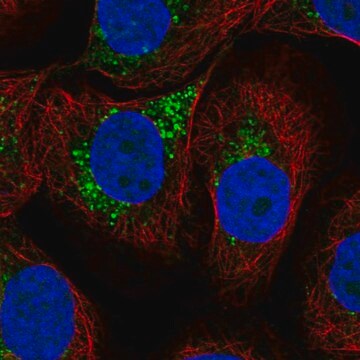NCSTUD001
MISSION® Synthetic microRNA Inhibitor
ath-miR416, Negative Control 1, Sequence from Arabidopsis thaliana with no homology to human and mouse gene sequences
Sinónimos:
Synthetic Tough Decoy, sTuD
Iniciar sesiónpara Ver la Fijación de precios por contrato y de la organización
About This Item
UNSPSC Code:
12352200
NACRES:
NA.51
Productos recomendados
product line
MISSION®
form
solid
mature sequence
GGUUCGUACGUACACUGUUCA
Sanger mature/minor accession no.
Sanger microRNA accession no.
storage temp.
−20°C
¿Está buscando productos similares? Visita Guía de comparación de productos
General description
Individual synthetic microRNA inhibitors were designed using a proprietary algorithm, which is based on the work of Haraguchi, T, et al. and in collaboration with Dr. Hideo Iba, University of Tokyo.† This algorithm utilizes the tough decoy (TuD) design. miRNA are known to regulate gene expression in a variety of manners, including translational repression, mRNA cleavage and deadenylation.
The MISSION synthetic miRNA Inhibitors are small, double-stranded RNA molecules designed to inhibit a specific mature miRNA. The miRNA inhibitors were designed using the mature miRNA sequence information from miRBase and are 2′-O-methylated RNA duplexes with a miRNA binding site on each strand. Optimal miRNA inhibition is provided after transfection due to the robust secondary structure of the inhibitor.
The MISSION synthetic miRNA Inhibitors are small, double-stranded RNA molecules designed to inhibit a specific mature miRNA. The miRNA inhibitors were designed using the mature miRNA sequence information from miRBase and are 2′-O-methylated RNA duplexes with a miRNA binding site on each strand. Optimal miRNA inhibition is provided after transfection due to the robust secondary structure of the inhibitor.
- Long lasting inhibition at very low dosage
- Excellent resistance to cellular nucleases
- Custom synthesis available for a variety of species
Other Notes
Based on miRBase V19
Legal Information
MISSION is a registered trademark of Merck KGaA, Darmstadt, Germany
signalword
Warning
hcodes
pcodes
Hazard Classifications
STOT RE 2 Inhalation
target_organs
Respiratory Tract
Storage Class
11 - Combustible Solids
wgk_germany
WGK 3
flash_point_f
Not applicable
flash_point_c
Not applicable
Certificados de análisis (COA)
Busque Certificados de análisis (COA) introduciendo el número de lote del producto. Los números de lote se encuentran en la etiqueta del producto después de las palabras «Lot» o «Batch»
¿Ya tiene este producto?
Encuentre la documentación para los productos que ha comprado recientemente en la Biblioteca de documentos.
Qing-Yan Lin et al.
Biotechnology letters, 42(1), 35-44 (2019-11-25)
The study is to research how miR-34-SIRT1 is regulated during hypoxia in lung cancer cells. Analysis of publicly available datasets from patients with NSCLC did not reveal significant genomic alterations in RBM38, SIRT1, HIF1A, MIR34A, MIR34B, and MIR34C, but expectedly
Yao Dai et al.
Redox biology, 16, 255-262 (2018-03-20)
Several miR/s that regulate gene/s relevant in atherogenesis are being described. We identified a miR (miR-98) that targets LOX-1, a receptor for ox-LDL, and speculated that it might be relevant in atherogenesis. MicroRNA-98 was predicted by bioinformatics tools. The effects
Ilker Tinay et al.
The Prostate, 78(12), 927-937 (2018-05-12)
MicroRNAs (miRNAs) are small non-coding RNAs, which negatively regulate gene expression and impact prostate cancer (PCa) growth and progression. Circulating miRNAs are stable and detectable in cell-free body fluids, such as serum. Investigation of circulating miRNAs presents great potential in
Let-7a-regulated translational readthrough of mammalian AGO1 generates a microRNA pathway inhibitor.
Anumeha Singh et al.
The EMBO journal, 38(16), e100727-e100727 (2019-07-23)
Translational readthrough generates proteins with extended C-termini, which often possess distinct properties. Here, we have used various reporter assays to demonstrate translational readthrough of AGO1 mRNA. Analysis of ribosome profiling data and mass spectrometry data provided additional evidence for translational
Nuestro equipo de científicos tiene experiencia en todas las áreas de investigación: Ciencias de la vida, Ciencia de los materiales, Síntesis química, Cromatografía, Analítica y muchas otras.
Póngase en contacto con el Servicio técnico





